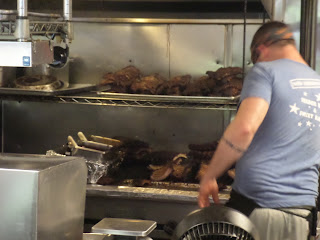The thrill for some barbecue fans is being a judge at a cookoff. For others, it’s taking on the challenging work of a cooking team. Sometimes the interests combine, and a cook wants to be certified as a judge, or a judge joins a cooking team to experience a cookoff from a different perspective.
 |
| Amanda Reed, her husband Jim, and best friend Kendra Battasta (left to right) show me the cookoff from a team's perspective. |
In Apex, NC at the
Peak City Pig Fest, I had the opportunity to join
Coastal Smoke, a team from Wilmington, NC. It has competed at events sanctioned by the
Kansas City Barbeque Society for about three years and successfully competed even earlier at community cookoffs.
 |
| Amanda and Kendra continue setup activities by placing a cooker in position. |
Last year at the
Smoke on the Harbor BBQ Throwdown in Mount Pleasant, SC, I met Amanda Reed, the head cook for Coastal Smoke. When I asked if I could join her team at an event in 2016, she was more than gracious and agreed that I could join her at the Pig Fest. Cooking with a team is a KCBS requirement for certification as a master judge, which I hope to gain when I have completed other requirements.
 |
| Amanda injects a pork butt with a solution of apple juice and vinegar. |
For the
Pig Fest, Amanda arrived about noon to set up and begin preparations. Because I wanted to see the cooking team in action from start to finish, I also arrived at noon. I was amazed at the constant motion of the team on the first day. So many steps – setup, meat inspection, cooks’ meeting, meat preparations -- have to be completed early to be ready for the quick pace of simultaneous actions on Saturday.
 |
| Pork butts are checked on a cooker. |
After spending nine hours on site on Friday, I left for the evening (and a comfortable, uninterrupted sleep). Amanda with her husband Jimmy and best friend Kendra Baratta continued with other activities that shortened their sleep considerably. (Although I briefly thought about staying with them, I long ago gave up “all nighters” and don’t get up in the middle of the night for anything.)
 |
| Kendra watches as Amanda puts chicken pieces on a cooker. |
Amanda, on the other hand, slept very little. Around 3 a.m., she started the fire so that the charcoals would be ready to smoke and provide residual heat when she placed the meats on the cookers. The brisket and two of four pork butts went on the cookers at 5 a.m. At 7 a.m., the other two pork butts were placed on the cookers. These two would provide the “
money muscle” (a small strip of loin meat opposite the blade bone side that is very tender) for the pork entry.
 |
| After slow cooking for several hours, the ribs are sliced for the turn-in box. |
On Saturday I returned to the team site just before 8 a.m. (I could tell that Amanda and the others hadn’t enjoyed much sleep.) I watched most of the preparations for the two remaining meat categories: ribs and chicken. The ribs went on the cooker at 8 a.m. and finally the chicken at 10 a.m.
 |
| The chicken looks so good as it is arranged in the turn-in box. |
So that the meats would be ready at the contest turn-in times (beginning at noon for chicken and continuing to 1:30 p.m. for brisket, the last one), each was prepared in advance – liquid injections, sauces, rubs. For example, the pork butts were injected with a solution of 3 parts apple juice and 1 part vinegar with a little sugar and salt. Even before arriving at the contest site, Amanda had prepped the chicken pieces by removing the bones, some skin and fat.
 |
| Kendra turns in chicken, the first entry, exactly at noon to Doug Reid, the KCBS rep. |
When the turn-in times arrived, I was surprised how calm the team was. Everything was going just like clockwork. Kendra was the “runner” and took each entry for turn-in at the designated time after Amanda had completed the final stages. Before a turn-in was ready, she had picked the best pieces, cuts, or slices from everything that had been cooked, which was three or four times what was needed for turn-in. For example, to select at least 6 pieces of chicken for the entry, 19 had been cooked.
 |
| Rib are perfectly placed in the turn-in box for a high appearance score. |
When the last entry was turned in, there was a brief sigh of relief before starting the final actions: cleaning and packing for the journey home – and waiting (more than 3 hours) for the awards ceremony. The results were bittersweet. The scores for chicken, ribs, and brisket were lower than hoped for, but Coastal Smoke placed among the top 10 teams in the pork category (even at turn-in, we thought that the pork was the best of the four entries submitted).
 |
| The pork entry, with money muscle lining the center, is ready for turn-in. |
Looking back on the weekend activities, I have much more appreciation for a cooking team. The investment of time, money, and effort is substantial. Few people, particularly the public that arrives mid-day on Saturday, realize the amount of work involved. For me, the weekend was great. Because I had judged at the
Peak City Pig Fest last year, seeing the event from the perspective of a cooking team was rewarding. If I ever spend time with a cooking team again, I can only hope that they are as congenial as
Coastal Smoke.
Note: To see an album with more pictures of my cooking experience with Coastal Smoke,
click here.



















